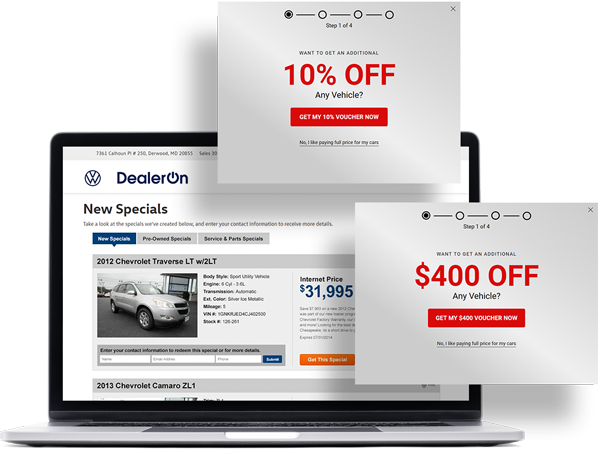

The game isn’t over when a car shopper is ready to leave your website. With exit-intent popups, you can make one last “Hail Mary” pass by presenting an offer that keeps your customer engaged.

Exit-intent popups are a proven, effective method for dramatically increasing your website’s conversion rate.
Give car shoppers one last chance to submit a lead on your website by leveraging the power of exit-intent popups.
Your website’s purpose is to generate leads. In much the same way as a potential customer might walk through your doors, look at every car in the lot, then leave without making a single offer, many people who find themselves on your website will leave without submitting a lead.
On certain occasions, these users have no intention of buying, and engaging with them is never going to lead to anything fruitful. Many times, though, engaging them in the right way can convert a bounce into a lead. Exit-intent popups are your last line of defense against lost customers and are an incredibly effective one at that.
What is an Exit-Intent Popup?
An exit-intent popup is exactly what it sounds like: a popup that appears when a visitor to your website demonstrates an intent to leave. It’s a final attempt to engage a visitor ready to end their visit. The best part is the utter lack of risk: the person was leaving anyway, so if a popup is an unforgivable annoyance, it doesn’t matter. They were already leaving.
The popup itself is typically an offer of some kind, related to the page the customer was browsing. For VDPs, an offer on a vehicle’s price can be effective. For your service department, an offer of a free or discounted service. Each offer should be relevant to the page being browsed. Since cost is often a sticking point to a conversion, directly addressing this need goes to the core of your customers’ needs.
Why Use Exit-Intent Popups?
In the simplest terms, because they work.
Exit-intent popups provide a backstop, giving your visitors one last chance to convert. Sometimes all it takes is a little nudge, and an exit intent popup can do just that. Tailored to your audience, they are effective at engagement and won’t annoy a customer into leaving. They’re already gone. One last effort to obtain a lead is risk-free.
Exit-intent popups provide a backstop, giving your visitors one last chance to convert. Sometimes all it takes is a little nudge, and an exit-intent popup can do just that.
It also reduces cart abandonment. In the world of automotive retailing, this often takes the form of a visitor abandoning a lead submission form partway through filling it out. An enticement can keep them on the page and inspire them to complete the form.
Lastly, it’s another way to increase engagement with your website. Giving your visitors a personalized engagement opportunity can both encourage them to interact, but also inspire trust and create a relationship.
How Do Exit-Intent Popups Work?
To a user, exit-intent popups work organically. They won’t even notice the trigger. As they leave, they’ll get the option (and its accompanying reward) to stick around.
The website tracks either the movement of the cursor or scrolling behavior depending on the device being used to browse. Combining this with a behavior-analyzing algorithm, sites can accurately predict when a user is ready to depart for greener pastures.

Exit-intent technology allows you to monitor user behavior and present offers before they leave your website.
When the website exit behavior is detected, the site deploys the prepared popup message. Designed correctly, the popup then disrupts the action of leaving, giving your visitor an incentive to submit their lead information. Address your user’s pain points and provide real value with your offers and messaging; you’ll create an opportunity to salvage what was going to be a lost lead.
The best part about exit-intent popups is that they’re completely unobtrusive and won’t harm the user experience. They can detect when a user is leaving with incredible accuracy and will not appear under other circumstances. Additionally, only those who were going to leave anyway would ever see them. The absolute worst-case scenario is that a customer you were never going to get anyway closes a popup.
How You Can Use Exit-Intent Popups
The best way to utilize exit-intent popups is to look at your website experience. Determine where visitors tend to leave and why. This will indicate where to place them and often what kinds of offers will retain them.
The most obvious is on VDPs (Vehicle Details Page). Customers browsing these tend to be motivated, and the most common pain point is price. An interested shopper can be ready to leave, but shaving a bit off the price can be just the thing that keeps the person around.
The best part about exit-intent popups is that they’re completely unobtrusive and won’t harm the user experience.
The service department is the unsung hero of any dealership. Comparison price shopping is a common reason users will abandon these pages to view a competitor. With exit-intent messaging, you can address this concern directly with a coupon, either with a price discount, a buy-one-get-one offer, or a free check-up. That extra incentive can be just the thing to tip the scales in your favor.
Lead Driver Behavioral Targeting
Part of the Lead Driver family of features, Behavioral Targeting is a meticulously engineered exit-intent system designed to keep prospects engaged on your website and dramatically increase the odds of capturing a lead.
Behavioral Targeting gives you the power to create exit-intent messages that can accurately determine when a user is about to leave. Patent-pending technology even allows you to create personalized messages depending on the user’s browsing behavior. With fully customizable Behavioral Targeting, you can engage with your customers in a manner as unique as they are.
We’ve found that dealers using Behavioral Targeting typically see a 25%-30% increase in conversions than those without it, and sell an additional 10-20 vehicles per month.
Offers can vary based on the type of pages being viewed. A customer browsing inventory can get one while another customer looking over your service department can get another. Having this high level of personalized advertising working for you will greatly increase your conversions and lead to more sales. We’ve found that dealers using Behavioral Targeting typically see a 25%-30% increase in conversions than those without it, and sell an additional 10-20 vehicles per month.
You don’t have to take our word for it. Schedule your demo today and we’ll be happy to show you exactly how Behavioral Targeting can increase your leads. We’ll not only walk you through what Behavioral Targeting can do for your store but show you a host of other DealerOn exclusive features; all designed and developed to help you move more metal.


